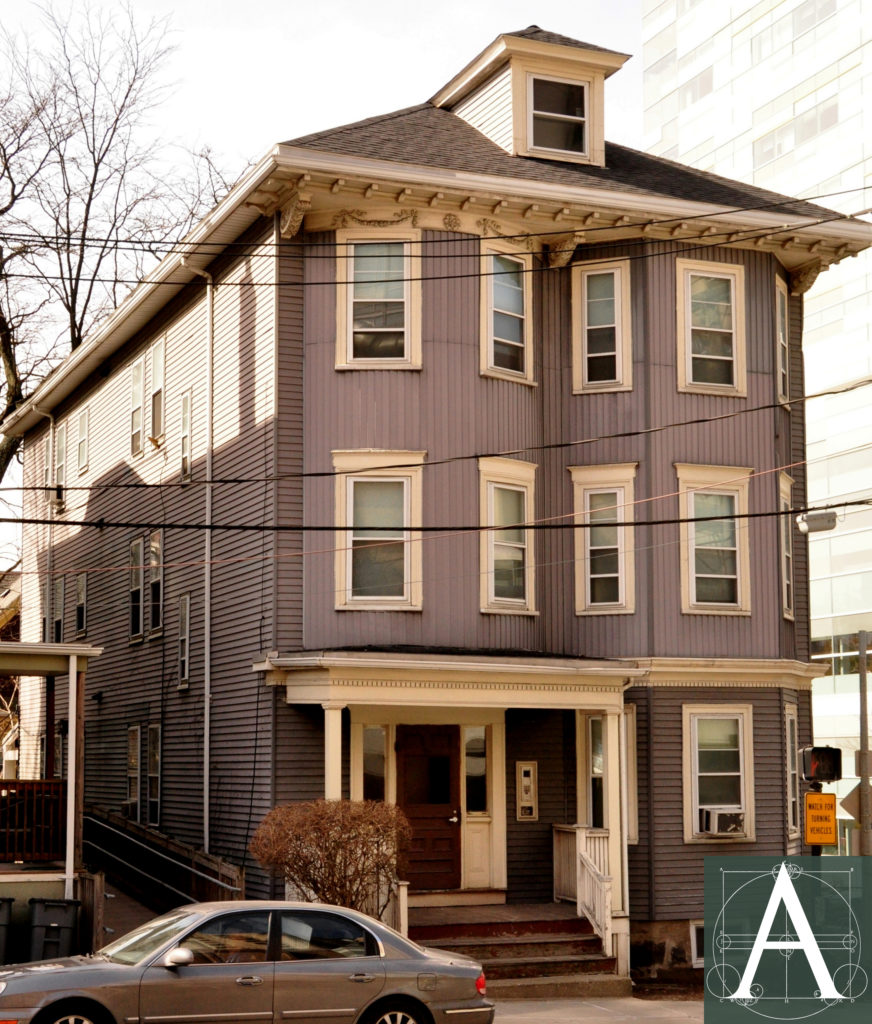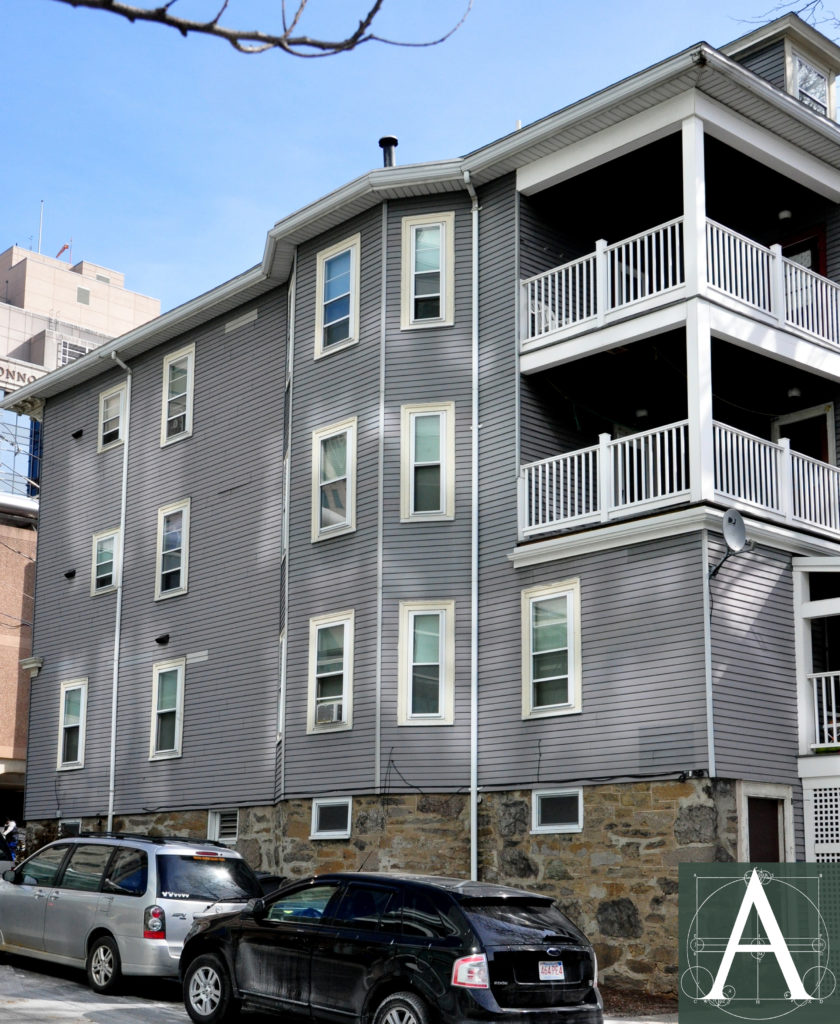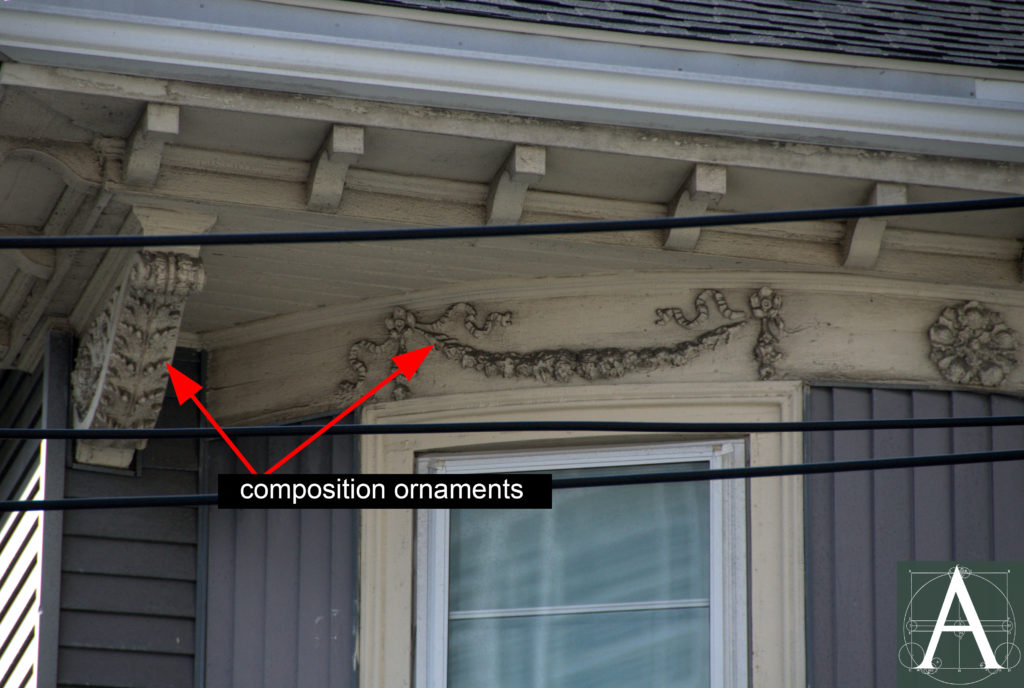Notable Elements
- Mortar applied over irregular stone faces, tooled and lined-out in white to give the appearance of random ashlar [Foundation]
- Composition ornaments consisting of festoons and acanthus brackets [Exterior]
History
The Mary Sullivan Three-Decker is one of a large number of two- and three-family houses constructed on Fenwood Road and Francis Street at the foot of Boston’s Parker Hill in the last years of the nineteenth century and the first decade of the twentieth by Jeremiah C. Spillane, a real estate developer. Spillane acquired a large parcel of land in this area in 1897 and quickly laid out streets and building lots. The majority of buildings constructed in the area were substantial wood-frame, two- and three-family houses. Building permits usually list Spillane as the architect and builder of these residences, but no evidence of Spillane’s architectural training or experience has been uncovered. Other permits for buildings constructed by Spillane list individual architects; however, the similarity of the buildings’ plans and decoration suggests that architects were engaged primarily to produce drawings necessary for obtaining building permits more quickly than could be done by a single office, and to individualize some of the building details, perhaps to the specifications of initial buyers.
It is likely that the Sullivan Three-Decker at 52 Francis Street was designed by Frederick W. Mahoney, a Roxbury architect who is known to have designed three nearly identical structures on nearby parcels at 32, 36 & 44 Francis Street. According to original building permits, the construction cost of these buildings was typically between $5,000 and $6,000. Within a span of eight years, Spillane constructed more than twenty multifamily houses on the side streets of the neighborhood, in addition to several masonry apartment houses located on Huntington Avenue.
Three-family houses in the area were primarily constructed along Francis Street and resembled the Sullivan Three-Decker in possessing three-storey, rectangular massing with bay windows at their facades, hip roofs and a variety of composition ornaments applied to cornices, window heads and porches. Apartments contained a parlor or double parlor, dining room, kitchen, pantry and three or four bedrooms each. Initially purchased by upwardly mobile working-class and middle-class families with a high proportion of immigrants and first-generation Americans, apartments in the Sullivan Three-Decker and its neighboring buildings were typically occupied by an extended single family or a family with two or three lodgers.
Spillane was active in the real estate business from 1899 to1913, and was directly responsible for the construction of twenty of the houses in this area, including 11, 15, 19, 32, 35, 36, 40, 43, 49, 54 & 56 Fenwood Road, and 12, 16, 20, 32, 34, 36, 38, 44, 50 & 52 Francis Street. At least eight professional architects are recorded as working in the Francis Street and Fenwood Road District. Most were local firms well-known for producing high-quality, one- and two-family houses and triple-deckers in Roxbury, Jamaica Plain and Brookline. The most prolific of the designers in the district was Samuel Rantin and Son of Roxbury, who designed 30 and 73 Fenwood Road, 40 Francis Street, 733 Huntington Ave (the Harmon Commercial Block) and 24 St. Albans Street. Frederick W. Mahoney of Roxbury designed three buildings, at 32, 36 & 44 Francis Street. Architects P. J. Cantwells, Timothy Desmond, Cornelius Russell, J. Schwartz (the Avondale apartments at 777-779 Huntington Ave.) and R. H. Watson are also represented in the district. The Boston Landmarks Commission Inventory Form for 170 St. Alphonsus Street notes that “Samuel Rantin and Son… were responsible for designing during the 1890’s through the 1910’s, many triple-decker houses of unusually high quality—in the Parker Hill, Highland Park, and Hyde Square (Jamaica Plain) areas.” A collection of architectural drawings by Rantin and Son is contained in the archives of Historic New England.
By the 1960s, Francis Street and the adjacent streets developed by Spillane had suffered deterioration and abandonment due to the migration of former residents to Boston’s suburbs. Much of the area was acquired by Harvard University. Most buildings in the area were subsequently transferred to the Roxbury Tenants of Harvard, a tenants’ cooperative that renovated the buildings by subdividing most apartments into smaller units. Original interior finishes were nearly entirely removed in the 1980s; however, notable exterior features remain in a rich variety of composition ornament and an unusually well preserved variety of mortar joints, including lined-out, tinted and beaded mortar joints preserved on foundations throughout the district. Once common, these methods of finishing mortar joints have been forgotten as evidence of them has weathered away. [See: Foundation]
Date
1900
Builder/Architect
Frederick W. Mahoney, architect (attribution); Jeremiah Spillane, developer
Building Type
Three-decker containing one apartment per storey
Foundation
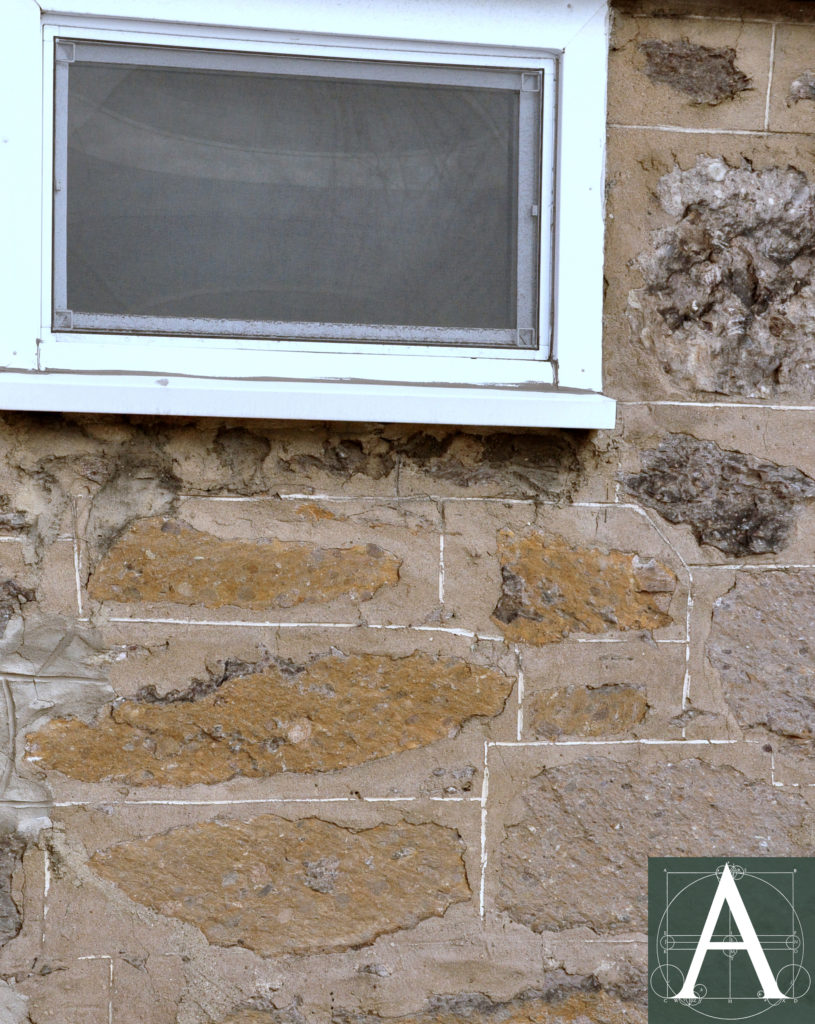
mortar joints ruled and lined out in white to give the appearance of more finely cut random ashlar masonry
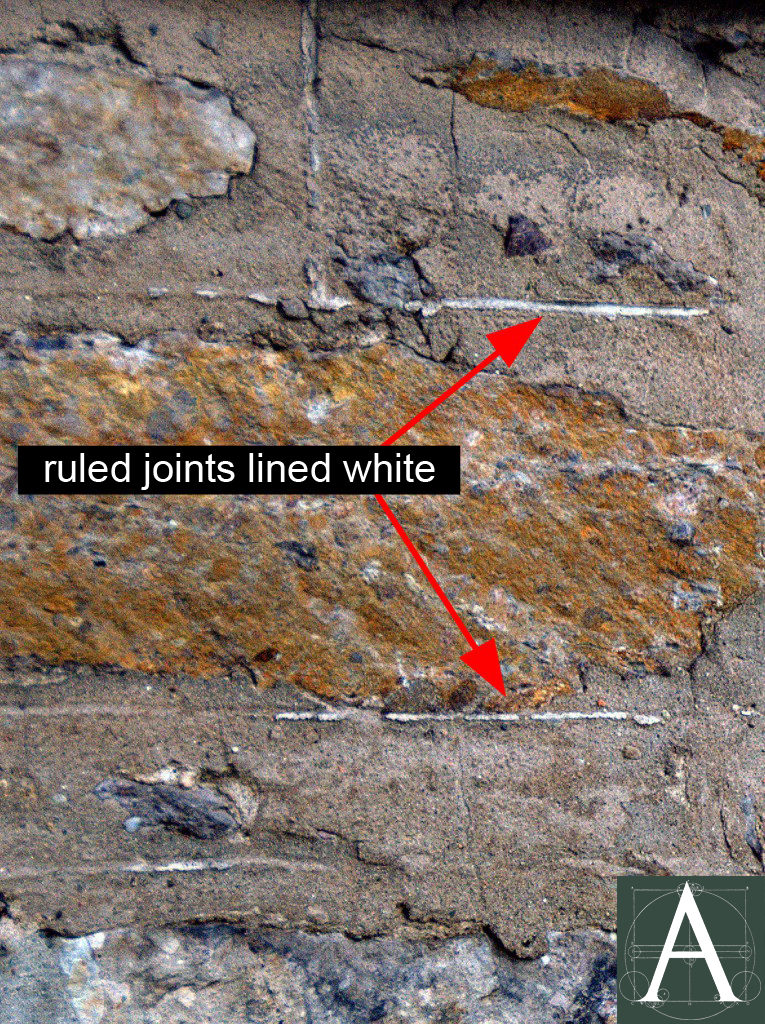
detail of irregular stone work and wide mortar joints ruled and tinted with white to resemble more finely cut random ashlar
As with the majority of buildings constructed in the Francis Street-Fenwood Road area, the foundation of the Sullivan Three-Decker is constructed of Roxbury Puddingstone that was quarried on or near the building’s site. The stonework is laid in random rubble with wide, irregular mortar joints that have been scored and lined-out with white pigment (chemical composition not identified) to give the appearance of ashlar. In some areas, mortar has been applied over large stone faces and scored to contain a false mortar joint in order to enhance the rectilinear appearance of random ashlar. Lined-out mortar joints have been used for centuries over coarser masonry materials to give the appearance of finer, more regular masonry finishes. The majority of such finishes have weathered away and not been replaced in-kind; however, examples survive in sheltered locations on buildings throughout the Francis Street-Fenwood Road area, most notably at 32, 36 & 44 Fenwood Road and at 22 Francis Street, in addition to 52 Francis Street. Providing further evidence of the intentional quality of these finishes, sections of foundation that were originally concealed by the front and rear porches are constructed in random rubble with untooled bedding mortar at their joints, as they were never intended to be exposed to view.
Frame
Building permits report that buildings in this area were constructed with mortise-and-tenon wood construction (braced frame). Building frames were not available for examination during the most recent building assessment (2014); however, braced frame construction remained in use for architect-designed buildings at least as late as 1887 and probably into the early twentieth century.
Exterior
All elevations are currently clad with aluminum siding that conceals original wooden finishes. Notable period elements include the façade’s two bay windows, one of which is bowed in an arc, the other three-sided, and a deep cornice at the façade’s eaves decorated with composition ornament festoons and acanthus brackets in the form of oversized modillions. Ornaments such as these are found throughout the Francis Street-Fenwood Road area, but appear to have been used more lavishly on the two-family houses found on Fenwood Road than they were on the three-family houses built on Francis Street. It is not known whether these elements were selected entirely by the developer/architect or if potential buyers were offered options from which to choose, as many of the same details appear in different contexts on buildings throughout the area.
Contributor
Brian Pfeiffer, architectural historian; Wendy Frontiero, historical research
Sources
Unpublished conditions assessment conducted by Wendy Frontiero & Brian Pfeiffer, 2014.
“Francis Street – Fenwood Road District,” unpublished nomination to the National Register of Historic Places. Wendy Frontiero, 2015. Filed at the Massachusetts Historical Commission.
Boston City Directories: 1875 – 1931.
Boston Daily Globe. “Real Estate,” Dec. 16, 1897; “Schoolhouse Lots,” Jan. 8, 1902; “Spillane on Trial,” Sept. 20, 1907; “Declares His Innocence,” Sept. 21, 1907.
Bromley, G. W. Atlas of the City of Boston. 1884, 1890, 1899, 1906, 1915, 1931.
City of Boston, Boston Landmarks Commission (Rosalind Pollan and Edward Gordon). 1984 Survey and Planning Grant; Part I – Parker Hill/Mission Hill Project Completion Report, 1985.

